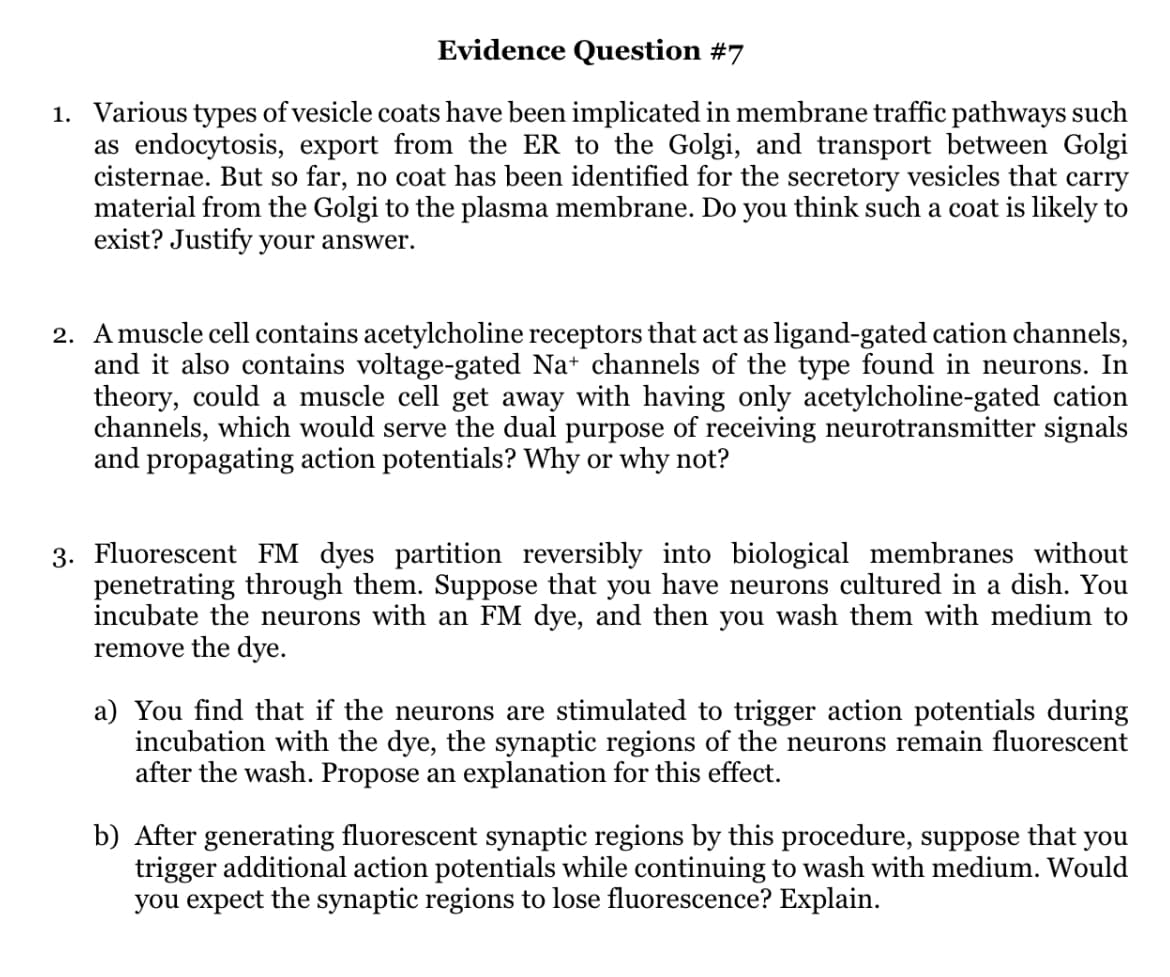b) After generating fluorescent synaptic regions by this procedure, suppose that you trigger additional action potentials while continuing to wash with medium. Would you expect the synaptic regions to lose fluorescence? Explain.
b) After generating fluorescent synaptic regions by this procedure, suppose that you trigger additional action potentials while continuing to wash with medium. Would you expect the synaptic regions to lose fluorescence? Explain.
Human Anatomy & Physiology (11th Edition)
11th Edition
ISBN:9780134580999
Author:Elaine N. Marieb, Katja N. Hoehn
Publisher:Elaine N. Marieb, Katja N. Hoehn
Chapter1: The Human Body: An Orientation
Section: Chapter Questions
Problem 1RQ: The correct sequence of levels forming the structural hierarchy is A. (a) organ, organ system,...
Related questions
Question
Number 3B

Transcribed Image Text:Evidence Question #7
1. Various types of vesicle coats have been implicated in membrane traffic pathways such
as endocytosis, export from the ER to the Golgi, and transport between Golgi
cisternae. But so far, no coat has been identified for the secretory vesicles that carry
material from the Golgi to the plasma membrane. Do you think such a coat is likely to
exist? Justify your answer.
2. A muscle cell contains acetylcholine receptors that act as ligand-gated cation channels,
and it also contains voltage-gated Na+ channels of the type found in neurons. In
theory, could a muscle cell get away with having only acetylcholine-gated cation
channels, which would serve the dual purpose of receiving neurotransmitter signals
and propagating action potentials? Why or why not?
3. Fluorescent FM dyes partition reversibly into biological membranes without
penetrating through them. Suppose that you have neurons cultured in a dish. You
incubate the neurons with an FM dye, and then you wash them with medium to
remove the dye.
a) You find that if the neurons are stimulated to trigger action potentials during
incubation with the dye, the synaptic regions of the neurons remain fluorescent
after the wash. Propose an explanation for this effect.
b) After generating fluorescent synaptic regions by this procedure, suppose that you
trigger additional action potentials while continuing to wash with medium. Would
you expect the synaptic regions to lose fluorescence? Explain.
Expert Solution
This question has been solved!
Explore an expertly crafted, step-by-step solution for a thorough understanding of key concepts.
Step by step
Solved in 3 steps

Knowledge Booster
Learn more about
Need a deep-dive on the concept behind this application? Look no further. Learn more about this topic, biology and related others by exploring similar questions and additional content below.Recommended textbooks for you

Human Anatomy & Physiology (11th Edition)
Biology
ISBN:
9780134580999
Author:
Elaine N. Marieb, Katja N. Hoehn
Publisher:
PEARSON

Biology 2e
Biology
ISBN:
9781947172517
Author:
Matthew Douglas, Jung Choi, Mary Ann Clark
Publisher:
OpenStax

Anatomy & Physiology
Biology
ISBN:
9781259398629
Author:
McKinley, Michael P., O'loughlin, Valerie Dean, Bidle, Theresa Stouter
Publisher:
Mcgraw Hill Education,

Human Anatomy & Physiology (11th Edition)
Biology
ISBN:
9780134580999
Author:
Elaine N. Marieb, Katja N. Hoehn
Publisher:
PEARSON

Biology 2e
Biology
ISBN:
9781947172517
Author:
Matthew Douglas, Jung Choi, Mary Ann Clark
Publisher:
OpenStax

Anatomy & Physiology
Biology
ISBN:
9781259398629
Author:
McKinley, Michael P., O'loughlin, Valerie Dean, Bidle, Theresa Stouter
Publisher:
Mcgraw Hill Education,

Molecular Biology of the Cell (Sixth Edition)
Biology
ISBN:
9780815344322
Author:
Bruce Alberts, Alexander D. Johnson, Julian Lewis, David Morgan, Martin Raff, Keith Roberts, Peter Walter
Publisher:
W. W. Norton & Company

Laboratory Manual For Human Anatomy & Physiology
Biology
ISBN:
9781260159363
Author:
Martin, Terry R., Prentice-craver, Cynthia
Publisher:
McGraw-Hill Publishing Co.

Inquiry Into Life (16th Edition)
Biology
ISBN:
9781260231700
Author:
Sylvia S. Mader, Michael Windelspecht
Publisher:
McGraw Hill Education